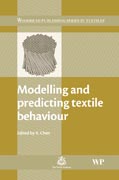
The textile industry can experience a vast array of problems. Modelling represents a group of techniques that have been widely used to explore the nature of these problems, it can highlight the mechanisms involved and lead to predictions of the textile behaviour. This book provides an overview of how textile modelling techniques can be used successfully within the textile industry for solving various problems. The first group of chapters reviews the different types of models and methods available for predicting textile structures and behaviour. Chapters include modelling of yarn, woven and nonwoven materials. The second group of chapters presents a selection of case studies, expressing the strengths and limitations and how various models are applied in specific applications. Case studies such as modelling colour properties for textiles and modelling, simulation and control of textile dyeing are discussed. With its distinguished editor and international range of contributors, Modelling and predicting textile behaviour will be essential reading material for textile technologists, fibre scientists and textile engineers. However, this book will also be an important information source in an academic setting. INDICE: PART 1 MODELLING THE STRUCTURE AND BEHAVIOUR OF TEXTILES Structural hierarchy in textile materials: an overview X Chen and J W S Hearle, The University of Manchester, UK The textile hierarchy. Modelling of fibres from the molecular level. Modelling of fibre behaviour. Modelling of yarns and cords. Modelling of fabrics. Sources of further information and advice. References. Fundamental modelling of textile fibrous structures S Grishanov, De Montfort University, UK Introduction. Fibre classification. Fibre functions in textile materials and composites. Modelling fibre structure. Statistical models of fibre geometry. Modelling mechanical behaviour of single fibres. Viscoelastic properties of fibres. Modelling fibre friction. Modelling fibre assemblies. Conclusions. References. Yarn modelling R Ognjanovic, Innoval Technology Limited, UK Introduction. Yarn construction. Types of models to predict the structure and properties of yarns. Applications and examples. Future trends in yarn modelling. Sources of further information and advice. References. Modelling the structures and properties of woven fabrics E Vidal-Salle and P Boisse, INSA Lyon, France Introduction: The importance and objectives of modelling woven fabrics. The mechanical behaviour of woven fabrics. Different approaches for modelling the mechanical behaviour of woven fabrics at different scales. Structure and geometry of the unit woven cell. Specific experimental tests. 3D simulation of the deformation of the unit woven cell at the mesoscopic level. Image analyses: full field digital image correlation measurements and x-ray tomography. Conclusions and future trends. References. Modelling of nonwoven materials N Mao andS J Russell, University of Leeds, UK Introduction. Constructing physical models of nonwoven structure. Modelling of pore size and pore size distribution innonwoven fabrics. Tensile strength. Modelling the bending rigidity of nonwoven fabrics. Modelling the specific permeability of nonwovens. Thermal resistance and thermal conductivity. Acoustic impedance. Particle filtration in nonwoven filters. Future trends and sources of further information and advice. References. Modelling and visualization of knitted fabrics Y Kyosev, Niederrhein University of Applied Sciences and W Renkens, ALC Computertechnik GmbH, Germany Aim and objectives of modelling knitted structures. Classification of knitted structures. Scales in the structure. Structural elements of knitted structures at meso-scale. Modelling steps. Model building. Post-processing. Other types of models. Application areas of the simulated fabrics and future trends. Conclusions. References. PART 2 CASE STUDIES Modelling of fluid flow and filtration through woven fabrics M A Nazarboland, X Chen and J W S Hearle, University of Manchester, R Lydon and M Moss, Clear Edge Group, UK Introduction. Various techniques in modelling fluid flow and filtration. Model design and analysis. Influence of fabric parameters on the flow performance. Influence of fluid flow and fabric parameters on filtration performance. Influence of particle properties on filtration performance. Application of fluid flow and filtration modelling. Future trends. References. Modelling, simulation and control of textile dyeing R Shamey, North Carolina State University, USA Introduction. Sorption isotherms. Dye diffusion models. Models relating the dyeing parameters to the quality of dyeing. Numerical simulation of package dyeing. Applications. Future trends. Acknowledgment. References. Modelling colour properties for textiles D Oulton, The University of Manchester, UK Introduction. The types of model used. A case study in colour communication. Future trends in colour modelling. Commercial vendors and their products. References. 3D modelling, simulation and visualisation techniques for drape textiles and garments F Han, Middlesex University and G Stylios, Heriot-Watt University, UK Introduction. Review of 3D textile models. Automatic measurement of fabric mechanics. Drape measurement and evaluation. Key principles of 3D mass-spring models. Clothing simulation: strengths, limitations and suggested improvements. Experimental results and discussions. Applications and examples. Conclusions and future trends. References. Recognition, differentiation and classification of regular repeating patterns in textiles M A Hann and B G Thomas, University of Leeds, UK Introduction. The study of pattern: historical precedents. Symmetry in pattern: fundamental concepts. The classification of motifs. The seven classes of border patterns. The seventeen classes of all-over patterns. Colour symmetry. Conclusions. References. Modelling of 3D cellular textile composites for protection against trauma impact X Chen, The University of Manchester, UK Introduction. Mathematical description of cellular textile structures. CAD/CAM of 3D cellular woven fabrics.Experimental study of properties of 3D cellular composites. Theoretical characterisation of 3D cellular composites. Discussions and conclusions. Future trends. References. Development and application of expert systems in the textile industry R Shamey, North Carolina State University, USA Introduction. System principles. Strengths and limitations of expert systems. The applications of expert systems in the textile industry. Future trends. Sources of further information and advice. References.
- ISBN: 978-1-84569-416-6
- Editorial: CRC Press
- Encuadernacion: Cartoné
- Páginas: 560
- Fecha Publicación: 01/11/2009
- Nº Volúmenes: 1
- Idioma: Inglés
